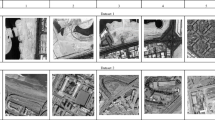Abstract
On-orbit semantic segmentation can produce the target image tile or image description to reduce the pressure on transmission resources of satellites. In this paper, we propose a fully convolutional network for on-orbit semantic segmentation, namely light-weight edge enhanced network (LEN). For the model to be pruned, we present a new model pruning strategy based on unsupervised clustering. The method is performed according to the \(l_1\)-norm of each filter in the convolutional layer. And it effectively guides the pruning of filters and corresponding feature maps in a short time. In addition, the LEN uses a trainable edge enhanced module called enhanced domain transform to further optimize segmentation performance. The module fully exploits multi-level information of the object to generate the edge map and performs edge-preserving filtering on the coarse segmentation. Experimental results suggest that the models produce competitive results while containing only 1.53 M and 1.66 M parameters respectively on two public datasets: Inria Aerial Image Labeling Dataset and Massachusetts Buildings Dataset.
Access this chapter
Tax calculation will be finalised at checkout
Purchases are for personal use only
Similar content being viewed by others
References
Maggiori, E., Tarabalka, Y., Charpiat, G., Alliez, P.: Can semantic labeling methods generalize to any city? The Inria aerial image labeling benchmark. In: IEEE IGARSS, pp. 3226–3229 (2017). https://doi.org/10.1109/IGARSS.2017.8127684
Bischke, B., Helber, P., et al.: Multi-task learning for segmentation of building footprints with deep neural networks. arXiv preprint: arXiv:1709.05932 (2017)
Khalel, A., El-Saban, M.: Automatic pixelwise object labeling for aerial imagery using stacked U-Nets. arXiv preprint: arXiv:1803.04953 (2018)
Han, S., Pool, J., Tran, J., Dally, W.: Learning both weights and connections for efficient neural network. In: Advances in NIPS, pp. 1135–1143 (2015)
Zhou, H., Alvarez, J.M., Porikli, F.: Less is more: towards compact CNNs. In: Leibe, B., Matas, J., Sebe, N., Welling, M. (eds.) ECCV 2016, Part IV. LNCS, vol. 9908, pp. 662–677. Springer, Cham (2016). https://doi.org/10.1007/978-3-319-46493-0_40
Wen, W., Wu, C., Wang, Y., Chen, Y., Li, H.: Learning structured sparsity in deep neural networks. In: Advances in NIPS, pp. 2074–2082 (2016)
Li, H., Kadav, A., Durdanovic, I., Samet, H., Graf, H.P.: Pruning filters for efficient ConvNets. In: International Conference on Learning Representations (2017)
Lin, G., Milan, A., Shen, C., Reid, I.: RefineNet: multi-path refinement networks for high-resolution semantic segmentation. In: Proceedings of the IEEE Conference on CVPR, pp. 1925–1934 (2017). https://doi.org/10.1109/CVPR.2017.549
Bertasius, G., Shi, J., Torresani, L.: High-for-low and low-for-high: efficient boundary detection from deep object features and its applications to high-level vision. In: ICCV, pp. 504–512 (2015). https://doi.org/10.1109/ICCV.2015.65
Chen, L.C., Barron, J.T., Papandreou, G., Murphy, K., Yuille, A.L.: Semantic image segmentation with task-specific edge detection using CNNs and a discriminatively trained domain transform. In: Proceedings of the IEEE Conference on CVPR, pp. 4545–4554 (2016). https://doi.org/10.1109/CVPR.2016.492
Hinton, G.E., Mnih, V.: Machine learning for aerial image labeling (2013)
Chen, L.C., Papandreou, G., Kokkinos, I., Murphy, K., Yuille, A.L.: DeepLab: semantic image segmentation with deep convolutional nets, atrous convolution, and fully connected CRFs. IEEE Trans. PAMI 40(4), 834–848 (2018)
Hu, J., Li, L., Lin, Y., Wu, F., Zhao, J.: A Comparison and Strategy of Semantic Segmentation on Remote Sensing Images. arXiv preprint: arXiv:1905.10231 (2019)
MacQueen, J.: Some methods for classification and analysis of multivariate observations. In: Proceedings of the Fifth Berkeley Symposium on Mathematical Statistics and Probability, vol. 1(14), pp. 281–297 (1967)
Bezdek, J.C., Ehrlich, R., Full, W.: FCM: the fuzzy c-means clustering algorithm. Comput. Geosci. 10(2–3), 191–203 (1984)
Ester, M., Kriegel, H.P., Sander, J., Xu, X.: A density-based algorithm for discovering clusters in large spatial databases with noise. In: KDD 1996, vol. 34, pp. 226–231 (1996)
Rousseeuw, P.J.: Silhouettes: a graphical aid to the interpretation and validation of cluster analysis. J. Comput. Appl. Math. 20, 53–65 (1987). https://doi.org/10.1016/0377-0427(87)90125-7
Tibshirani, R., Walther, G., Hastie, T.: Estimating the number of clusters in a data set via the gap statistic. J. R. Stat. Soc. Ser. B (Stat. Methodol.) 63(2), 411–423 (2001). https://doi.org/10.1111/1467-9868.00293
Liu, Y., Cheng, M. M., Hu, X., Wang, K., Bai, X.: Richer convolutional features for edge detection. In: CVPR, pp. 3000–3009 (2017). https://doi.org/10.1109/CVPR.2017.622
Everingham, M., Eslami, S.A., Van Gool, L., Williams, C.K., Winn, J., Zisserman, A.: The Pascal visual object classes challenge: a retrospective. Int. J. Comput. Vis. 111(1), 98–136 (2015). https://doi.org/10.1007/s11263-014-0733-5
Author information
Authors and Affiliations
Corresponding author
Editor information
Editors and Affiliations
Rights and permissions
Copyright information
© 2019 Springer Nature Switzerland AG
About this paper
Cite this paper
Hu, J., Li, L., Lin, Y., Wu, F., Zhao, J. (2019). Light-Weight Edge Enhanced Network for On-orbit Semantic Segmentation. In: Tetko, I., Kůrková, V., Karpov, P., Theis, F. (eds) Artificial Neural Networks and Machine Learning – ICANN 2019: Deep Learning. ICANN 2019. Lecture Notes in Computer Science(), vol 11728. Springer, Cham. https://doi.org/10.1007/978-3-030-30484-3_27
Download citation
DOI: https://doi.org/10.1007/978-3-030-30484-3_27
Published:
Publisher Name: Springer, Cham
Print ISBN: 978-3-030-30483-6
Online ISBN: 978-3-030-30484-3
eBook Packages: Computer ScienceComputer Science (R0)




